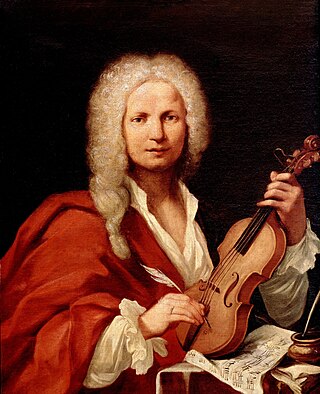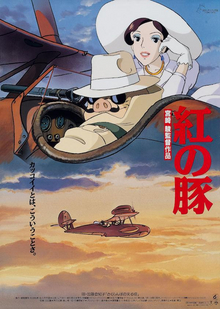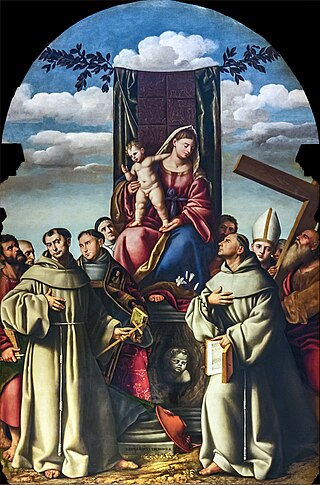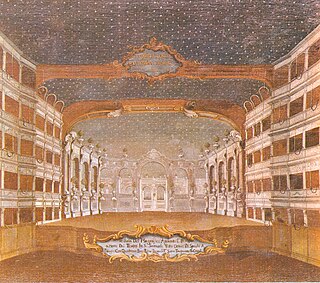Related Research Articles

Antonio Lucio Vivaldi was an Italian composer, virtuoso violinist and impresario of Baroque music. Along with Johann Sebastian Bach and George Frideric Handel, Vivaldi ranks amongst the greatest Baroque composers and his influence during his lifetime was widespread across Europe, giving origin to many imitators and admirers. He pioneered many developments in orchestration, violin technique and programmatic music. He consolidated the emerging concerto form into a widely accepted and followed idiom.

Porco Rosso is a 1992 Japanese animated adventure fantasy film written and directed by Hayao Miyazaki, based on his 1989 manga Hikōtei Jidai. The film stars the voices of Shūichirō Moriyama, Tokiko Kato, Akemi Okamura and Akio Ōtsuka. It was produced by Toshio Suzuki, animated by Studio Ghibli, and distributed by Toho. The score was composed by Joe Hisaishi.

The Four Seasons is a group of four violin concerti by Italian composer Antonio Vivaldi, each of which gives musical expression to a season of the year. These were composed around 1718–1720, when Vivaldi was the court chapel master in Mantua. They were published in 1725 in Amsterdam, together with eight additional concerti, as Il cimento dell'armonia e dell'inventione.

Domenico Grimani was an Italian nobleman, theologian and cardinal. Like most noble churchman of his era Grimani was an ecclesiastical pluralist, holding numerous posts and benefices. Desiderius Erasmus dedicated his Musica to Grimani.

Bernardo Strozzi, named il Cappuccino and il Prete Genovese, was an Italian Baroque painter and engraver. A canvas and fresco artist, his wide subject range included history, allegorical, genre and portrait paintings as well as still lifes. Born and initially mainly active in Genoa, he worked in Venice in the latter part of his career. His work exercised considerable influence on artistic developments in both cities. He is considered a principal founder of the Baroque style in Venetian painting. His powerful art stands out by its rich and glowing colour and broad, energetic brushstrokes.

Bernardino Licinio was an Italian High Renaissance painter of Venice and Lombardy. He mainly painted portraits and religious canvases.
The year 1678 in music involved some significant events.

Lorenzo Carlo Domenico Milani Comparetti was an Italian Catholic priest. He was an educator of poor children and an advocate of conscientious objection.

Bartolomeo Guidobono (1654–1709) was an Italian painter known for his scenes with angelic looking figures bathing in soft lighting, which show the influence of Correggio. His elegant and graceful style was very popular in Genoa. He is also known as il Prete di Savona or Prete Bartolomeo da Savona.

Giuseppe Berto was an Italian writer and screenwriter. He is mostly known for his novels The Sky Is Red and Incubus.

Glauco Onorato was an Italian actor and voice actor.

Teatro San Samuele was an opera house and theatre located at the Rio del Duca, between Campo San Samuele and Campo Santo Stefano, in Venice. One of several important theatres built in that city by the Grimani family, the theatre opened in 1656 and operated continuously until a fire destroyed the theatre in 1747. A new structure was built and opened in 1748, but financial difficulties forced the theatre to close and be sold in 1770. The theatre remained active until 1807 when it was shut down by Napoleonic decree. It reopened in 1815 and was later acquired by impresario Giuseppe Camploy in 1819. In 1853 the theatre was renamed the Teatro Camploy. Upon Camploy's death in 1889, the theatre was bequeathed to the City of Verona. The Venice City Council in turn bought the theatre and demolished it in 1894.
Anna Girò, also known as l'Annina del Prete Rosso, la Nina del Prete Rosso, or l'Annina della Pietà, was the stage name of Anna Maria(?) Maddalena Tessieri, an Italian mezzo-soprano/contralto of the 18th century. She is best remembered for her numerous collaborations with composer Antonio Vivaldi who wrote operatic roles for her. She is the singer who performed the greatest number of Vivaldi's operas, the one who kept them in her repertoire the longest time and who made them known across the largest geographical area.

La fida ninfa is an opera by Antonio Vivaldi to a libretto by Scipione Maffei. The opera was first performed for the opening of the Teatro Filarmonico in Verona on 6 January 1732. Among the arias is "Alma oppressa de sorte crudele".

Streetwise priests are Roman Catholic priests who exercise their spiritual mandate by living in structures in direct contact with the "street", which is their mission land. Historical streetwise priests include Philip Neri (1515–1595) and John Bosco (1815–1888).

Il prato macchiato di rosso is a 1973 Italian film directed by Riccardo Ghione.

Sebastiano Biancardi, known by the pseudonym Domenico Lalli, was an Italian poet and librettist. Amongst the many libretti he produced, largely for the opera houses of Venice, were those for Vivaldi's Ottone in villa and Alessandro Scarlatti's Tigrane. A member of the Accademia degli Arcadi, he also wrote under his arcadian name "Ortanio". Lalli was born and raised in Naples as the adopted son of Fulvio Caracciolo but fled the city after being implicated in a bank fraud. After two years wandering about Italy in the company of Emanuele d'Astorga, he settled in Venice in 1710 and worked as the "house poet" of the Grimani family's theatres for the rest of his career. In addition to his stage works, Lalli published several volumes of poetry and a collection of biographies of the kings of Naples. He died in Venice at the age of 62.

Grosso mogul, also Il grosso mogul, or capitalised [Il] Grosso Mogul, RV 208, is a violin concerto in D major by Antonio Vivaldi. The concerto, in three movements, is an early work by the Venetian composer. Around the mid-1710s Johann Sebastian Bach transcribed the concerto for organ, BWV 594, in C major. A simplified version of the violin concerto, RV 208a, without the elaborated cadenzas that appear in manuscript versions of RV 208, and with a different middle movement, was published around 1720 in Amsterdam as concerto #11 of Vivaldi's Op. 7.

The Priest's Hat is a 1944 Italian historical thriller drama film directed by Ferdinando Maria Poggioli and starring Roldano Lupi, Lída Baarová and Luigi Almirante. It is based on the 1888 novel of the same title by Emilio De Marchi.
References
- ↑ "Vivaldi, il prete rosso", Film Commission Torino Piemonte
- ↑ "Vivaldi, the Red Priest". www.condor-pictures.com.
- ↑ ""Vivaldi The Red Priest", ultimo ciak- Film.it". www.film.it.